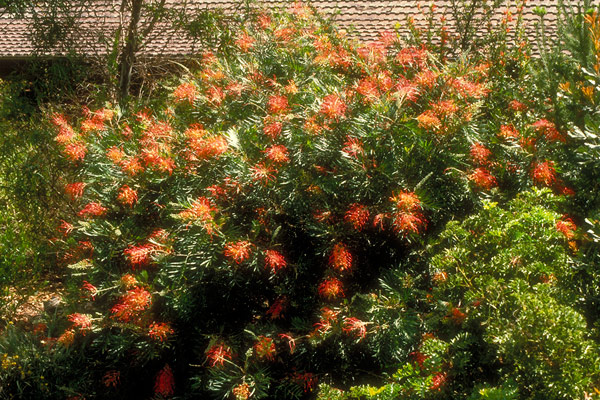General Description:
Grevillea “Ned Kelly” is a medium shrub which can reach about 2 metres in height by 3 metres wide. Large orange-red racemes of flowers occur throughout the year. This cultivar is also known as “Mason’s Hybrid” and “Kentlyn” and it originated at the Kentlyn, New South Wales Australian Plant nursery in the 1970s from G.banksii and an upright form of G.bipinnatifida. It was heavily promoted as G. “Ned Kelly” and it is now best known by that name.
All of the “Robyn Gordon” group of cultivars are bushy shrubs with attractive lobed foliage. The older cultivars (“Robyn Gordon”, “Superb”, “Ned Kelly” and “Coconut Ice”) have proven to be reliable in a wide range of climates and soils and there is every reason to expect the newer forms to be equally hardy. Pruning is usually not required but plants can tolerate moderate to heavy pruning if necessary. A sunny, well drained position is preferable in the garden and plants are tolerant of at least moderate frost. Fertilisers containing phosphorus are best avoided. The flowers attract honey-eating birds.
It is worth noting that the foliage of several grevilleas is known to cause skin irritations to individuals who are sensitive to compounds contained in the leaves and the group of grevilleas most commonly implicated in causing this contact dermatitis is the “Robyn Gordon” group of cultivars. Accordingly, care should be exercised in locating these plants in the garden – it would be best to avoid locating them where people would need to regularly brush past the plants and it would also be best to avoid planting them in school playgrounds.
Further information can be found in the article “Grevilleas as Plant Allergens“.
Propagation of all of these cultivars is fairly easy from cuttings. Because of the hybrid origin of these plants, seedlings will not come true to type and must not be given the original cultivar name. Seed, however, seems to be set very rarely with these plants.

Grevillea ‘Ned Kelly’, showing the flowering habit
Photo: Brian Walters
 Australian Native Plants Society (Australia)
Australian Native Plants Society (Australia)